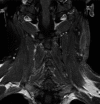Utility of sodium fluorescein in recurrent cervical vagus schwannoma surgery
- PMID: 37941611
- PMCID: PMC10629342
- DOI: 10.25259/SNI_451_2023
Utility of sodium fluorescein in recurrent cervical vagus schwannoma surgery
Abstract
Background: Cervical schwannoma is a rare neoplasm that usually occurs like a nondolent lateral neck mass but when growing and symptomatic requires radical excision. Sodium fluorescein (SF) is a dye that is uptake by schwannomas, which makes it amenable for its use in the resection of difficult or recurrent cases.
Methods: We describe the case of a patient presenting with a recurrence of a vagus nerve schwannoma in the cervical region and the step-by-step technique for its complete microsurgical exeresis helped by the use of SF dye.
Results: We achieved a complete microsurgical exeresis, despite the presence of exuberant perilesional fibrosis, by exploiting the ability of SF to stain the schwannoma and nearby tissues. That happens due to altered vascular permeability, allowing us to better differentiate the lesion boundaries and reactive scar tissue under microscope visualization (YELLOW 560 nm filter).
Conclusion: Recurrent cervical schwannoma might represent a surgical challenge due to its relation to the nerve, main cervical vessels, and the scar tissue encompassing the lesion. Although SF can cross both blood-brain and blood-tumor barriers, the impregnation of neoplastic tissue is still greater than that of nonneoplastic peripheric tissues. Such behavior may facilitate a safer removal of this kind of lesion while respecting contiguous anatomical structures.
Keywords: Cervical carotid lodge; Cervical vagus schwannoma; Neck vascular-nervous fascicle; Sodium fluorescein; Transcervical approach.
Copyright: © 2023 Surgical Neurology International.
Conflict of interest statement
There are no conflicts of interest.
Figures



References
-
- Callum EN. Neurinoma of cervical sympathetic chain. Br J Surg. 1949;37:117. - PubMed
LinkOut - more resources
Full Text Sources
